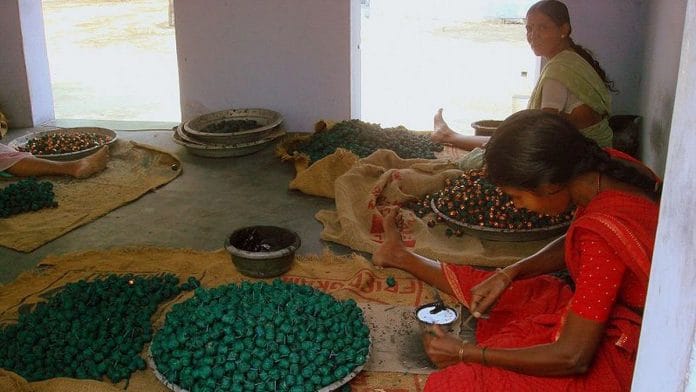Sivakasi fireworks manufacturers want Supreme Court to define green cracker, say they have been following emission norms for 15 years.
Bengaluru: The Supreme Court’s decision to promote “green crackers” this Diwali has put out the light in India’s fireworks hub of Sivakasi, Tamil Nadu.
Manufacturers faced huge losses due to the ban on crackers last year, and the misery is likely to continue now that only low-emission crackers are allowed, after the Supreme Court banned the use of barium nitrate, which is used in nearly 75 per cent of fireworks.
The manufacturers and their workers are facing an uncertain future, because the technology to produce eco-friendly fireworks has not been transferred to them, and they cannot produce such crackers in time for the festival.
“There is no cracker in world that will have zero emission. It does not exist. In Sivakasi, we have been following the guidelines that have been set and are working towards cleaner and greener fireworks,” B. Abiruben, vice-president of Tamil Nadu Fireworks and Amorces Manufacturers’ Association (TANFAMA), told ThePrint.
By July-August this year, Sivakasi had already completed this year’s production. According to TANFAMA, there is a huge pile-up of unsold crackers from last year.
The future of those working in the units is now at stake because if manufacturing is hit, they will bear the brunt.
“The workers are paid on a per-piece basis. A worker earns Rs 450 a day. If there are no sales, there will be no manufacture, and he will lose his job,” said Aasai Thambi, president of TANFAMA.
Also read: 68% of Delhi-NCR residents won’t burn crackers this Diwali to help keep pollution in check
What exactly has been banned?
Fireworks manufacturers use barium salts — such as barium nitrate — to produce colourful flames in pyrotechnics. This emits toxic fumes, causing high levels of air pollution.
A 2017 report by the Council of Scientific and Industrial Research, New Delhi, was the basis for the court banning the use of barium nitrate.
“We are seeking clarity from the court as to what defines a green cracker. A firework that has less emission is a green cracker, but we have been following the standards set by the regulating agencies for nearly 15 years now,” Abiruben said.
TANFAMA is also hoping for a favorable verdict Wednesday — it has sought a modification to the judgment, which allowed bursting of crackers only between 8 pm and 10 pm.
“We expect the court to allow us to burst crackers in the morning as Tamilians celebrate Diwali then, unlike the rest of India. This decision too will have an impact on our sales,” Thambi said.
Safe crackers still far away
Scientists believe that “green crackers” will help reduce air pollution and end the reliance on harmful chemicals, making Diwali safer and a lot more environment-friendly.
Two of India’s top research institutes, the National Environmental Engineering Research Institute (NEERI) and the Central Electronics Engineering Research Institute (CEERI), have developed crackers that are not only environment-friendly, but also 15-20 per cent cheaper than conventional crackers, according to Dr Harsh Vardhan, Union Minister for Science & Technology as well as the Environment.
However, there is a big hitch — these crackers will not be available in the markets anytime soon.
After conducting research for nearly a year, CSIR’s NEERI has developed three types of firecrackers which they have named Safe Water Releaser (SWAS), Safe Thermite Cracker (STAR) and Safe Minimal Aluminum (SAFAL).
The scientists say that these crackers have the unique property of releasing water vapour or air which will match the sound and display of traditional firecrackers.
These crackers are now being tested at the Petroleum and Explosives Safety Organisation.
NEERI is also testing the efficacy of another indigenous product called ‘Bijli’, a prototype that does not emit sulphur dioxide and has eliminated the formation of ash as residue. These firecrackers will reduce emissions by 15-30 per cent.
NEERI scientist Sadhana Rayulu said her organisation has devised an eco-friendly flower pot firecracker, an all-time favorite among children. They have replaced the chemicals with zeolite, which will drastically reduce nitrogen and sulphur emissions in the air.
CEERI, meanwhile, is working on ‘electronic crackers’, which will produce sound and light without fire.
‘E-crackers’ and ‘E-Ladi’ are based on high-voltage electrostatic discharge to generate light and sound effects, but the question is will these green crackers provide the same thrill and action that traditional crackers do?
“There will be differences from traditional crackers. But the way they burst and generate sparkles is absolutely identical. You don’t have to light it and run away from it,” said Santanu Chaudhury, director of the Pilani-based CSIR-CEERI.
Also read: 2-hour window to burst crackers a welcome step, will help change people’s mindset, say doctors
“We are also working on a thermal activation of such crackers. You will get the same feel of a cracker without polluting the environment. We are also looking to introduce patterns of sound and light which will make it more exciting. Emission-wise, it will close to nil.”
TANFAMA says CSIR scientists have not given them any directions yet on how to make green crackers.
“CSIR has visited Sivakasi once to take a look at the industry. Now they are saying they are working on it and they will begin sharing their information through the department of explosives,” said Abiruben.






